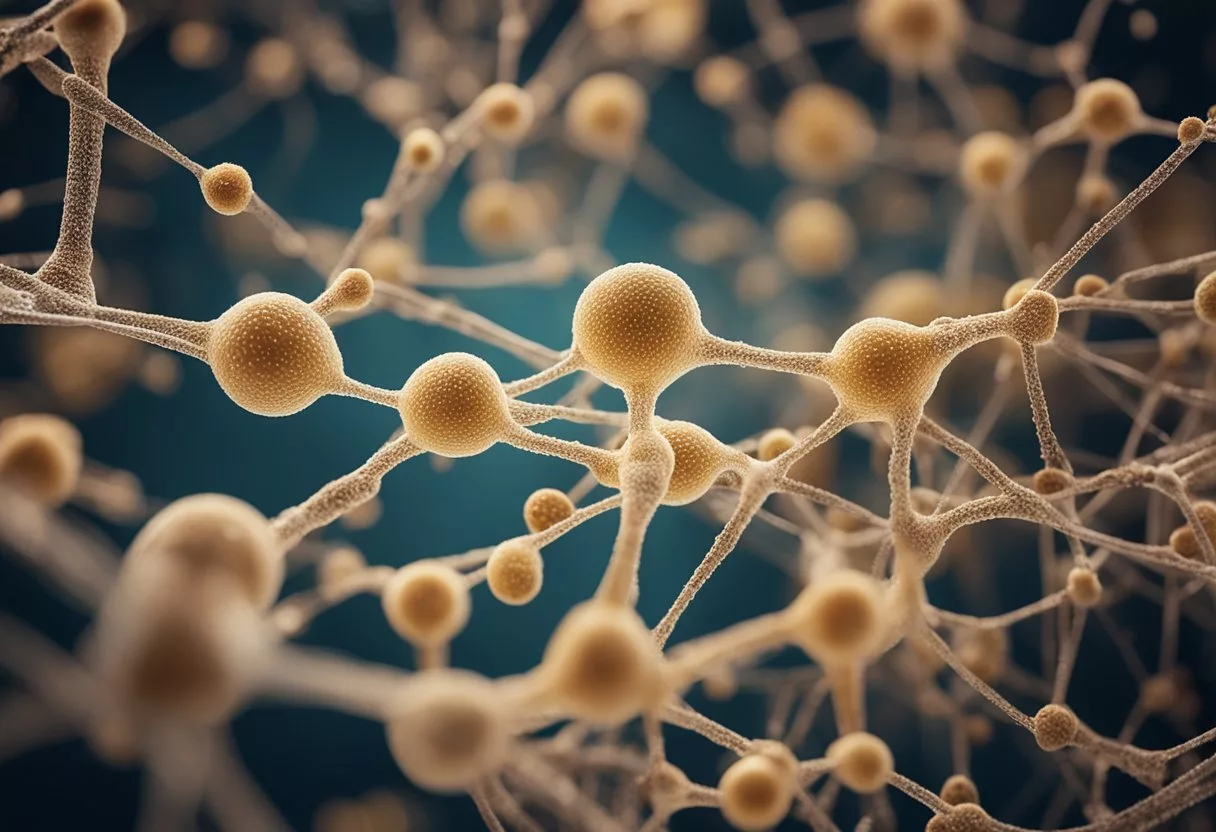Advanced glycation end products (AGEs) are harmful compounds that form when sugar interacts with proteins or fats in the body. High levels of AGEs are linked to serious conditions like diabetes, heart disease, and Alzheimer’s disease. AGEs can build up in the body through both internal processes and external sources, such as certain foods.

The process of forming AGEs is called glycation. This reaction can cause proteins and other molecules in the body to lose their normal function. Over time, this leads to tissue damage, inflammation, and other health problems, especially when AGEs accumulate in high amounts.
Reducing AGE intake can improve health. Avoiding foods cooked at high temperatures and limiting processed foods rich in sugars can help lower AGE levels. Learn more about how these compounds affect the body and how simple dietary changes can make a significant impact.
Key Takeaways
- AGEs form when sugar interacts with proteins or fats.
- High AGE levels are linked to several chronic diseases.
- Reducing dietary AGEs can improve health.
Biochemistry of Advanced Glycation End Products

Advanced glycation end products (AGEs) are formed through complex biochemical processes, primarily involving the nonenzymatic glycosylation of proteins, lipids, and nucleic acids. These processes play significant roles in various chronic diseases and aging.
Formation and Chemical Nature
AGEs are created through the Maillard Reaction, a sequence of reactions beginning with the nonenzymatic glycosylation of proteins and lipids. In this reaction, reducing sugars react with free amino groups to form Schiff bases.
These Schiff bases then rearrange into more stable Amadori products. Further oxidation and molecular rearrangements result in the formation of AGEs, such as carboxymethyl-lysine (CML) and pentosidine. The presence of intermediates like methylglyoxal accelerates AGE formation.
AGEs are chemically diverse, comprising various structures and functions, depending on the type of sugars and proteins involved.
Pathways and Intermediates
AGE formation proceeds through several pathways, including oxidative stress and the Maillard Reaction. Endogenous AGEs form naturally in the body during metabolism, while exogenous AGEs arise from dietary sources. Key intermediates, such as Amadori products and methylglyoxal, are critical in these pathways.
Methylglyoxal, a reactive dicarbonyl compound, substantially contributes to AGE formation. Other intermediates include fructosamines and advanced lipoxidation end products (ALEs). These molecules further interact with nucleic acids, leading to DNA glycation, which affects cellular functions and contributes to aging and disease progression, including diabetes and cardiovascular diseases.
AGEs and Chronic Diseases

Advanced glycation end products (AGEs) are harmful compounds formed when proteins or fats combine with sugars in the bloodstream. AGEs can contribute to various chronic diseases by promoting inflammation and oxidative stress. This section explores how AGEs impact cardiovascular health, diabetes, kidney and liver function, and cognitive health.
Cardiovascular Complications
AGEs play a significant role in cardiovascular diseases such as heart disease and atherosclerosis. They can cause arterial stiffness by cross-linking collagen and elastin in the arterial walls. This makes arteries less flexible, leading to increased blood pressure and vascular injury.
AGEs also trigger inflammation and oxidative stress in blood vessels. This contributes to the buildup of fatty deposits in the arteries, known as atherosclerosis. The presence of AGEs might increase the risk of heart attacks and strokes by making plaque in the arteries more prone to rupture.
Diabetes and Its Complications
Diabetes, particularly type 2, is closely linked with high levels of AGEs. In diabetics, poor blood sugar control leads to higher AGE formation through nonenzymatic glycosylation. AGEs contribute to insulin resistance, making it harder for insulin to lower blood sugar.
AGEs are involved in several diabetic complications. They damage blood vessels and kidneys, leading to diabetic nephropathy. This is a major cause of chronic kidney disease and can result in kidney failure. High AGE levels are also linked with retinopathy, a disease affecting the eyes, and neuropathy, which damages nerves.
Kidney and Liver Involvement
AGEs are toxic to the kidney and liver, which are vital for filtering blood and detoxifying the body. In the kidneys, AGEs can cause chronic kidney disease by inducing inflammation and fibrosis, which leads to loss of kidney function.
Patients with diabetes often experience kidney problems, including diabetic nephropathy. In severe cases, this can necessitate a kidney transplant. AGEs also affect the liver by promoting oxidative stress and inflammation, increasing the risk of liver diseases such as non-alcoholic fatty liver disease.
Neurodegenerative and Cognitive Disorders
AGEs contribute to the development of neurodegenerative diseases like Alzheimer’s disease. These compounds trigger inflammation and oxidative damage in the brain, leading to cognitive decline. AGEs accumulate in amyloid plaques and neurofibrillary tangles, which are characteristic of Alzheimer’s.
The presence of AGEs in the brain can impair cognitive functions, including memory and learning. This accumulation disrupts cellular processes, leading to brain cell damage and death. Managing AGE levels might offer a strategy to prevent or slow the progression of neurodegenerative conditions.
Mechanisms of AGEs Damage

Advanced glycation end products (AGEs) contribute to various diseases through mechanisms involving cell signaling, oxidative stress, and difficulties in eliminating these products from the body.
RAGE and Cell Signaling
AGEs bind to the receptor for advanced glycation end products (RAGE). This triggers several cell signaling pathways. The activation of these pathways can lead to inflammation and oxidative stress. One important pathway is the NF-κB pathway. When NF-κB is activated, it moves into the cell nucleus and increases the production of inflammatory cytokines.
RAGE is not always attached to the cell surface; there is also a soluble form of RAGE. The soluble receptor can bind to free AGEs, preventing them from activating cell surface RAGE. This reduces inflammation and damage. However, a high load of AGEs can overwhelm the soluble receptors, leading to increased cell signaling and damage.
Oxidative Stress and Inflammatory Response
AGEs generate oxidative stress by producing reactive oxygen species (ROS). This can damage lipids, proteins, and DNA in the cells. Besides direct damage, ROS further activates the NF-κB pathway. This creates a cycle of inflammation and oxidative stress.
Nitric oxide, important for endothelial function, gets reduced in the presence of high ROS. This leads to endothelial dysfunction, affecting blood vessels. Inflammation from AGEs also recruits immune cells that release more cytokines, sustaining the cycle of damage.
AGEs Accumulation and Clearance
AGEs accumulate in the body over time, particularly in conditions like diabetes and chronic kidney disease. The body has mechanisms to clear AGEs but these can become inefficient. Enzymes like glyoxalase can detoxify AGEs, but are often overwhelmed with excess production.
Macrophages can also engulf AGEs, yet high levels can impair their function. The kidneys are a major organ for AGE clearance, but renal dysfunction further reduces clearance, creating a vicious cycle. This accumulation exacerbates damage and accelerates aging-related diseases.
Nutritional Aspects and Dietary AGEs

Dietary advanced glycation end products (AGEs) are compounds that form when proteins, lipids, and sugars combine. Their presence in foods and the effects of cooking methods on their formation are crucial to understanding their impact on health.
Impact of Cooking Methods
Cooking methods significantly affect the formation of AGEs. High-temperature techniques like grilling, roasting, frying, broiling, and searing lead to higher levels of AGEs. For instance, grilling or frying meat can produce more AGEs compared to boiling or steaming.
On the other hand, moist heat methods such as boiling and steaming result in fewer AGEs. These methods use lower temperatures and involve water, which helps in reducing AGE formation. By choosing cooking techniques wisely, one can decrease the intake of dietary AGEs.
AGEs in Common Foods
Certain foods are high in AGEs, especially those that are animal-derived and processed. For example, red meats and cheeses have higher AGE content. Scrambled eggs, cream cheese, and bagels are also notable contributors. Even whole milk and processed foods like French fries contain significant levels of AGEs.
In contrast, plant-based foods like nuts, fruits, vegetables, legumes, and whole grains typically have lower AGE levels. These foods are not only lower in AGEs but also rich in antioxidants, which may help combat oxidative stress caused by AGEs.
Reducing Dietary AGEs
Reducing dietary AGEs involves both choosing the right foods and cooking methods. A low-AGE diet emphasizes plant-based foods and encourages the consumption of foods cooked with moist heat.
Incorporating more nuts, fruits, vegetables, legumes, and whole grains can significantly lower AGE intake. Additionally, avoiding processed foods and selecting cooking methods like boiling, steaming, or poaching helps minimize AGE formation. Making these adjustments can potentially reduce the negative impact of dietary AGEs on health.
Clinical Aspects and Management

Advanced glycation end-products (AGEs) contribute to various chronic diseases and oxidative stress. Managing AGEs involves therapeutic interventions and lifestyle modifications to reduce harm and improve health outcomes.
Therapeutic Interventions
Several treatments aim to curb the harmful effects of AGEs. AGE inhibitors, such as aminoguanidine, prevent the formation of AGEs. These compounds are studied for their potential to slow the progression of diseases like diabetes and cardiovascular conditions. AGE breakers help by disrupting already formed AGEs, thus lessening tissue damage.
Pharmacological approaches also include enhancing insulin sensitivity to manage blood glucose and minimize AGE formation. Drugs targeting the receptor for AGEs (RAGE) can reduce inflammation and tissue damage linked to AGEs.
Including polyphenols in treatment plans is another approach. These compounds, found in foods like berries and green tea, possess antioxidant properties that fight oxidative stress. Researchers are exploring diverse strategies to reduce AGEs effectively.
Lifestyle Modifications
Lifestyle changes are crucial in managing AGEs. Reducing intake of dietary AGEs is important. Cooking methods impact AGE levels; grilling, roasting, and frying often increase AGE content. Opting for boiling or steaming foods can lower AGE intake.
Maintaining a healthy weight is also vital. Obesity raises the likelihood of higher AGE levels. Regular physical activity improves insulin sensitivity, helps in weight management, and reduces AGE production.
A diet rich in fruits, vegetables, and whole grains, which contain polyphenols and other antioxidants, can help. Avoiding high-AGE foods, such as processed meats and fast foods, is beneficial. Simple changes in diet and exercise routines can significantly impact AGE levels and overall health.
Research and Future Directions

Current research on advanced glycation end products (AGEs) involves innovative detection methods and potential drug developments. Socioeconomic factors also play a significant role in AGEs exposure, affecting public health outcomes.
Innovative Detection and Drug Development
Scientists are exploring new ways to detect AGEs more accurately and efficiently. Techniques such as mass spectrometry and immunoassays are being refined. These methods help in identifying specific biomarkers that indicate the presence of AGEs.
Developing drugs to inhibit AGEs formation is another crucial area of research. Some studies focus on AGE inhibitors like aminoguanidine, which slow the formation process. Additionally, polyphenols found in foods like fruits and vegetables show promise in reducing AGEs in the body. They act as antioxidants, neutralizing harmful compounds before they form AGEs.
Socioeconomic Factors in AGEs Exposure
Socioeconomic status (SES) significantly impacts exposure to AGEs. Lower SES often means limited access to healthy foods, leading to higher consumption of processed and high-sugar foods, increasing AGEs levels.
Research shows that education and income levels influence dietary choices and overall health. Communities with lower SES have higher rates of chronic diseases linked to AGEs, like diabetes and cardiovascular disease. Addressing these disparities requires targeted public health interventions and education programs to promote healthier diets.
By understanding these factors, policymakers can create strategies to reduce AGEs exposure across different socioeconomic groups, improving health outcomes.
AGEs and Extracellular Matrix Interactions

Advanced glycation end-products (AGEs) have a significant impact on the extracellular matrix (ECM). These interactions often lead to pathological effects, especially in chronic diseases.
AGEs are known to enhance vascular permeability. This means they make blood vessels more “leaky,” which can lead to swelling and inflammation.
The crosslinking of AGEs with extracellular matrix proteins like collagen and elastin strengthens and stiffens the ECM. This impacts the normal function and structure of tissues.
In liver cirrhosis, AGEs mediate crosslinking, making liver tissue more rigid. This is observed in cirrhotic liver tissue, as shown here.
AGEs also stimulate the production of metalloproteinases. These enzymes degrade the ECM, further contributing to tissue damage.
In kidney diseases, AGEs are significant in glomerulosclerosis. This condition involves the hardening of the tiny blood vessels in the kidneys, affecting their function.
Connective tissue growth factor (CTGF) is another key player. AGEs can increase the production of CTGF, a protein that promotes tissue fibrosis and scarring.
Addressing AGEs’ effects on the ECM could potentially lead to new treatments for diseases such as diabetes, cardiovascular diseases, and liver cirrhosis. Understanding these interactions is essential for developing strategies to mitigate their harmful impact.
Immune Response and AGEs

Advanced glycation end products (AGEs) affect the immune system in several ways. They interact with various receptors, including the receptor for advanced glycation end products (RAGE), which can lead to inflammation.
AGEs can cause immune cells to produce cytokines like IL-6 and TNF-α, which promote inflammation. This response is part of the body’s attempt to deal with these harmful molecules.
AGEs also play a role in autoimmune diseases. They can promote the formation of autoantibodies. These autoantibodies attack the body’s tissues, leading to conditions like rheumatoid arthritis.
The presence of AGEs can lead to endoplasmic reticulum stress. This stress affects the function of immune cells, causing them to react improperly to infections or other challenges.
AGEs are linked to diseases such as diabetes and atherosclerosis. These diseases are often accompanied by a heightened immune response. This can worsen symptoms and increase the risk of complications.
The consumption of alcohol can also increase the levels of AGEs in the body. This is particularly damaging because chronic alcohol consumption is associated with impaired immune function. The combination of increased AGEs and reduced immune efficiency can exacerbate health problems.
AGEs’ impact on the immune system makes them an important focus for research. Understanding how they function can lead to new treatments for diseases associated with chronic inflammation and immune dysfunction.
Frequently Asked Questions

Advanced glycation end products (AGEs) have significant health implications, especially concerning diabetes management, dietary impacts, skin health, and aging. Understanding and addressing AGEs can help mitigate potential risks.
What are the repercussions of advanced glycation end products on diabetes management?
AGEs contribute to complications in diabetes by increasing insulin resistance and promoting chronic inflammation. This can make blood sugar levels harder to control, leading to further health issues such as cardiovascular diseases.
How can one mitigate the effects of advanced glycation end products in the body?
Reducing AGE levels involves lifestyle changes like adopting a diet low in AGE-rich foods and incorporating antioxidants. Regular exercise also helps by improving metabolism and reducing oxidative stress, which in turn lowers AGE formation.
Which dietary adjustments are recommended to reduce the intake of advanced glycation end products?
Choosing fresh, whole foods over highly processed ones can reduce AGE intake. Methods like steaming, boiling, and poaching are preferable cooking techniques. Avoiding excessive grilling, frying, or broiling can also help minimize AGE consumption.
In what ways do advanced glycation end products impact skin health and aging?
AGEs cause cross-linking of collagen fibers, leading to reduced skin elasticity and firmness. This accelerates the aging process, resulting in wrinkles and sagging skin. Limiting sun exposure and using skincare products with antioxidants can mitigate these effects.
What are the symptoms indicating an excessive accumulation of advanced glycation end products?
High AGE levels may manifest as early signs of aging, such as wrinkles, age spots, and stiffness in joints. In diabetics, this can also include worsening of complications like retinopathy, neuropathy, and nephropathy.
How does the body create advanced glycation end products, and can this process be inhibited?
AGEs form through nonenzymatic reactions between sugars and proteins or lipids, a process accelerated by high blood sugar levels. Inhibition can be achieved by maintaining a healthy diet, controlling blood sugar, and using medications or supplements that block AGE formation.
